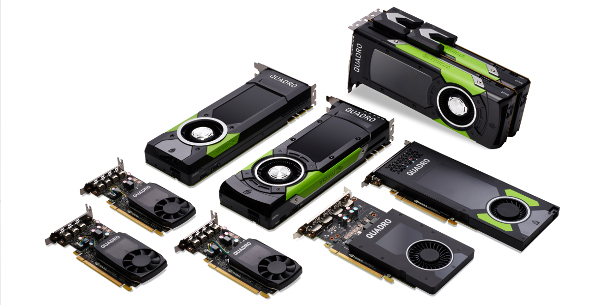Nvidia unveils six new Quadro workstation GPUs

Nvidia’s complete new Quadro Pascal product line-up. The GP100 is at the back with the previously announced P6000 and P5000 to its immediate left. The other new cards are towards the front.
Nvidia has unveiled six new GPUs in its Quadro family of workstation cards for graphics professionals: the Quadro GP100, P4000, P2000, P1000, P600 and P400.
The cards, which are all based on Nvidia’s current Pascal architecture, replace the company’s previous-generation M-series and K-series GPUs.
A complete line-up of Pascal workstation graphics cards
The five P-series cards – the P4000, P2000, P1000, P600 and P400 – are the most straightforward, rounding out the lower end of the new product range begun with the high-end P6000 and P5000 last year.
Each replaces an equivalent previous-generation card: in the case of the mid-range P4000 and P2000, the old Maxwell-based M4000 and M2000.
The entry-level P1000, P600 and P400 replace even older cards: the Kepler-based K1200, K620 and K420.
In each case, the benefits are the same as those for the P6000 and P5000: more CUDA cores and higher core clock speed than the older cards – and a corresponding increase in compute performance.
Memory doesn’t change as much: most of the new cards have the same amount of graphics RAM as their predecessors, aside from the P2000, which has 5GB of VRAM to the M2000’s 4GB.
Connectivity is also largely unchanged, although the entry-level cards have more mini-DP ports than their precursors. You can see handy comparison tables in this article on AnandTech.
The GP100: from server to workstation GPU
The most powerful of the new cards, the GP100, is more interesting, since it uses the same GP100 chip as that used in Nvidia’s high-end, server-only Tesla P100 cards.
Although Nvidia’s marketing material categorises it as higher-end than even the P6000, suited for “the most demanding rendering and GPGPU compute applications”, on paper, its specs are actually lower.
Its single-precision floating point compute performance of 10.3 Tflops puts it midway between the P6000 and P5000; and its 16GB of VRAM puts it on a par with the P5000, compared to the P6000’s 24GB.
The memory in question is HBM2 rather GDDR5X, and therefore has a much higher bandwidth – but for GPU rendering, raw quantity counts, since it determines the maximum size of a renderable scene.
Like the P6000, the GP100 has four DisplayPort 1.4 connectors and one DVI-D, and its maximum power consumption is actually slightly lower: 235W as opposed to 250W.
In the absence of any benchmarks, it’s hard to tell which card would perform better in production, but AnandTech reports that the GP100 is likely to be priced slightly higher than the P6000.
Nvidia suggests that users may link two GP100s together using its NVLink technology, which would bring the total graphics memory available to 32GB, but which would obviously also double that cost.
Pricing and availability
All six new Quadro cards are expected to become available in March.
Nvidia hasn’t announced pricing, but we’d assume that the P-series cards will be priced similarly to the last-gen cards they replace; and if AnandTech is right, the GP100 would come in somewhere above $5,000.
Read Nvidia’s official press announcement
Read more about the new Quadro workstation GPUs on Nvidia’s website
